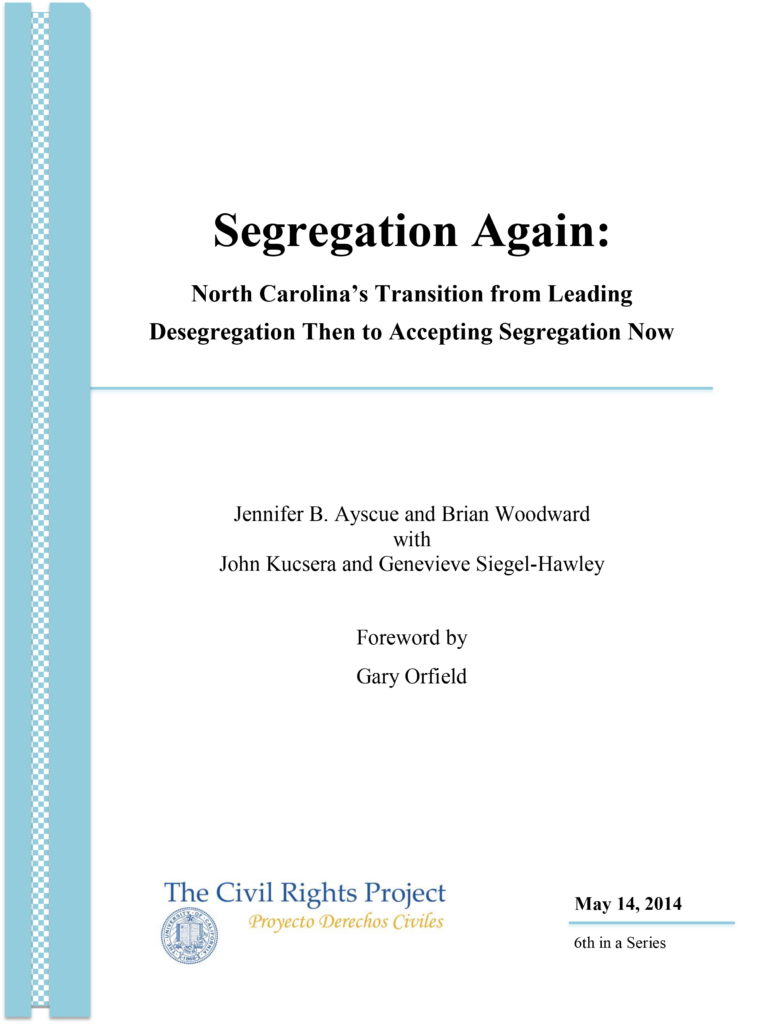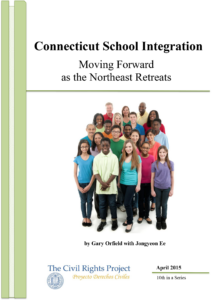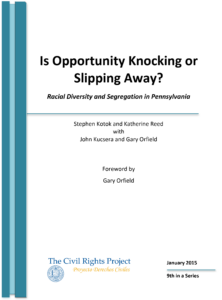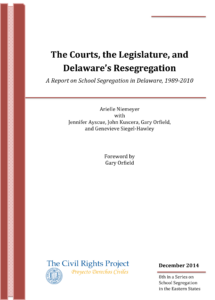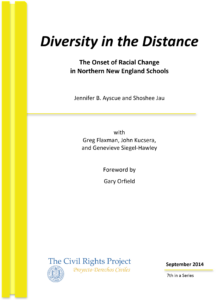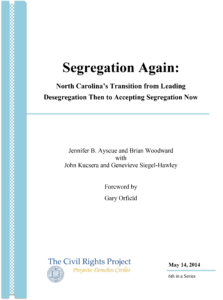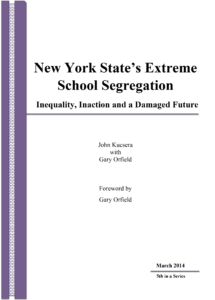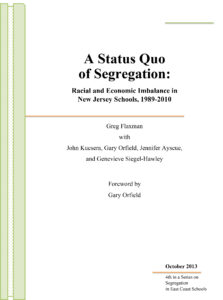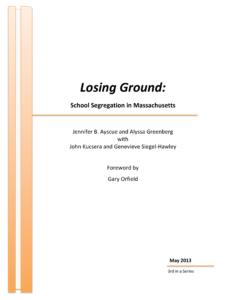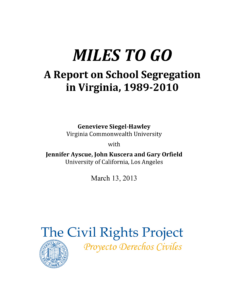Key Findings
Over the last two decades, the share of intensely segregated schools—those that enroll less than 10% white students—has tripled. In 2010, intensely segregated schools accounted for 10% of the state’s schools, up from only 3% in 1989.
The report also finds students increasingly isolated by poverty, which greatly intensifies the educational problems caused by racial separation. In 2010, 50% of the state’s students were low-income. However, the typical black and Latino students attended schools with 59% low-income students while the typical white and Asian students attended schools with 58% middle-class students.
The state’s public school enrollment is becoming more diverse and multiracial. Between 1989 and 2010, the white and black shares of enrollment decreased while the Latino and Asian shares rapidly increased. At 53% white, in 2010, the state’s enrollment was still majority white.
“It’s disappointing to see a state with such a strong educational history now accept segregation as the standard for its students,” said Jennifer Ayscue, co-author of the report and research associate at The Civil Rights Project. “If nothing is done, these trends toward increasing segregation are likely to continue, but there is hope and if the state’s residents and educators demand better, policies could be implemented to address these disturbing trends.”
Using 1989-2010 data from the National Center on Education Statistics, the report explores trends in enrollment and school segregation at the state level, as well as in three major metropolitan areas—Charlotte, Raleigh, and Greensboro. Summaries are also available on the metropolitan areas of Asheville, Durham-Chapel Hill, Fayetteville, Hickory-Lenoir-Morganton, Wilmington, and Winston-Salem.
The report summarizes decades of research indicating that segregated schools are strongly linked to multiple forms of unequal educational opportunity and outcomes. Minority segregated schools tend to have fewer experienced and less qualified teachers, high levels of teacher turnover, less stable student enrollments, inadequate facilities and learning materials, and high dropout rates. Conversely, desegregated schools are linked to profound benefits for all students, including improved academic achievement for minority students with no decline for white students, improved critical thinking skills, loftier educational and career expectations, reduction in students’ willingness to accept stereotypes, heightened ability to communicate and make friends across racial lines, and high levels of civic responsibility.
“North Carolina is presently at an educational crossroads. The state can continue on a path of reverting back toward an increasing number of segregated schools, knowing that educational inequities coincide with such schools,” stated Brian Woodward, co-author of the report and research associate at The Civil Rights Project. “Alternatively the state can take advantage of this pivotal moment by creating bold initiatives, as was done in the past, that provide all students, irrespective of race, access to a quality education. This is an opportunity for the state to use education proactively as a tool to change North Carolina’s future.”
The report emphasizes that North Carolina was once recognized as a leader in successful school desegregation. Just one day after the May 17, 1954, Brown decision, Greensboro was the first city in the South to publicly announce its adherence to Brown. Charlotte was catapulted to the national stage as the district successfully desegregated its schools following the landmark 1971 Swann decision. In 2000, Wake County became the first metropolitan district in the country to try to achieve diversity by focusing on socioeconomic status and academic inequality. Most school districts in the state are countywide districts, a structure that facilitates successful school desegregation efforts.
However, in the last decade, North Carolina and its school districts have done little to proactively maintain diverse and desegregated schools. Although not universally accepted, many districts across the state focus increasingly on neighborhood schools and deemphasize diversity.
Trends toward increasing segregation in the three largest metropolitan areas:
Metropolitan Charlotte
- The share of intensely segregated schools increased substantially from 0.1% in 1989 to 20.2% in 2010.
- One out of three black students and one out of four Latino students attended intensely segregated schools in 2010.
- Low-income students accounted for 47% of the metro’s enrollment in 2010; the typical black and Latino student attended a school with 60% low-income students while the typical white student attended a school with 64% middle-class students.
Metropolitan Raleigh
- The share of intensely segregated schools increased over the last two decades but remained very small at less than 3% in 2010.
- In 2010, between 65% and 82% of students in each racial group attended multiracial schools—those that have any three races representing 10% or more of the total school enrollment—an increase from one decade earlier when only 10-25% of each racial group attended such schools.
Metropolitan Greensboro
- The share of intensely segregated schools increased from 0.7% in 1989 to 15.8% in 2010.
- One out of four black students and one out of seven Latino students attended intensely segregated schools in 2010.
- Low-income students accounted for 53% of the metro’s enrollment in 2010; the typical black student’s school was 62% low income, the typical Latino student’s school was 64% low income, but the typical white student’s school was only 44% low income.
“North Carolina is losing some hard-won gains just when its changing population and the demands of its economy make them more important than ever,” commented Professor Gary Orfield, co-director of the Civil Rights Project. “There are better policies that would be a big win for the state’s future.”
The report provides multiple recommendations for creating and maintaining integrated schools, including developing student assignment policies that consider race among other factors, altering school choice plans to ensure they promote diversity, promoting collaboration between fair housing efforts and school policies, supporting communities experiencing racial change and resegregation by helping them create voluntary desegregation plans, and recruiting a more diverse teaching staff while training current teachers and administrators.
This report is the sixth in a series of 13 reports on school segregation trends in the Eastern States.
In the video below, Civil Rights Project graduate researchers, Jennifer Ayscue and Brian Woodward, present the findings of their report.
This report is part of a special series, “School Segregation Trends in the Eastern States.” These studies explore trends in enrollment and school segregation patterns from 1989 to 2010 at the state and regional levels, including various metro areas for each state. The reports also document the history of school desegregation in each state and across its geographic regions, including key desegregation cases and remedies, when applicable.
In compliance with the UC Open Access Policy, this report has been made available on eScholarship:
